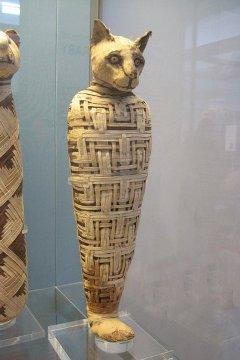Fake Mummies
Most of us are aware that the Egyptians mummified animals - cats, monkeys, crocodiles, bulls and ibis, to name just a few. The reason why they did it, however, is probably less well known.

| |
| Sacred bulls were buried in huge sarcophagii in the Serapeum of Saqqara. |
In some cases the animals were clearly sacred animals who were being ensured a place in the afterlife. The sacred bulls buried in the Serapeum at Saqqara are an example of this practice, for each bull was apparently believed to be a reincarnation of its predecessor and therefore worthy of special honour.
The same may be true of the crocodiles mummified in the Fayyum at Crocodilopolis, but with some other animals the reason appears to have been very different: a pilgrim or votary would pay for an animal to be mummified, either as a form of penance or as a meritorious action that would help to balance the heart against the feather of truth. This, of course, meant that the requirement for animals to be mummified sometimes exceeded the supply - and when has an entrepreneurially minded priest ever failed to rise to such an occasion?
The Rijksmuseum van Oudheden in Leyden, Holland, has recently been carrying out one of the largest projects to study mummies non-invasively ever undertaken. Dr Maarten J. Raven, curator of the museum, and radiologist Dr Wybren K. Taconis have been studying mummies from the museum for seven years and the results of their work have recently been published in "Radiological Atlas of Egyptian Mummies".
There are the usual comments on the various diseases and parasite infestations manifested in the human mummies and, of course, these are very interesting and worthy. The real interest, however, comes when the book turns to the examination of the mummified animals.
A mummified falcon turned out to be a beautifully wrapped bag of sand - presumably dead falcons were not to be had for love nor money at the time.
A different problem confronted the priests who mummified a lamb; the poor little creature was so small that when it had been swathed in multiple layers of linen it looked like a fat sausage with a slight bump at one end where the head was - nothing like a lamb at all. The solution, while drastic, was effective. The mummifiers simply cut the lamb's head off, stuck a stick in as a sort of pseudo-neck and bandaged the lot. The result was a very lamb-like and, presumably, saleable mummy.

| |
| You'd look surprised too if you found yourself embarking on the afterlife with six lives still in hand. |
It was when the all-seeing eye of the x-ray machine was turned on a mummified cat that the myth of Egypt as a nation of animal lovers was finally exploded.
I have always felt a bit sorry for these unfortunate cats, which look like a long shapeless sausage with a cat's head stuck on top. The effect is achieved by stretching the cat's fore legs down and tucking them under its tummy and then by stretching its back legs out and bandaging them rigidly in that position. Having once had to suffer three weeks in traction with a broken leg, I know how uncomfortable such a position can be - and to think of a poor moggy being stretched and bandaged like that for eternity, well, if I were such a cat, I would have a very unquiet spirit indeed!
However, strange as it may seem, it would appear that dead cats were almost as scarce as dead falcons, though in this case the mummy did indeed contain a cat - but a cat with a broken neck! Apparently some pilgrim turned up with his bag of coins in his hands, all eager to earn some merit in the eyes of the cat goddess, but the priests were right out of dead cats. The solution was to grab the nearest cat and - presumably behind a screen so as not to frighten the women and horses - break its neck with such violence that there is a gap of a good half an inch between the two parts of the spine!
No doubt the pilgrim paid his coins and went away happy with the assurance that his chances in front of Osiris had been improved. We can but hope that the All-Seeing Eye will inflict retribution for the deceased puss on the priest and not on the hapless devotee.





